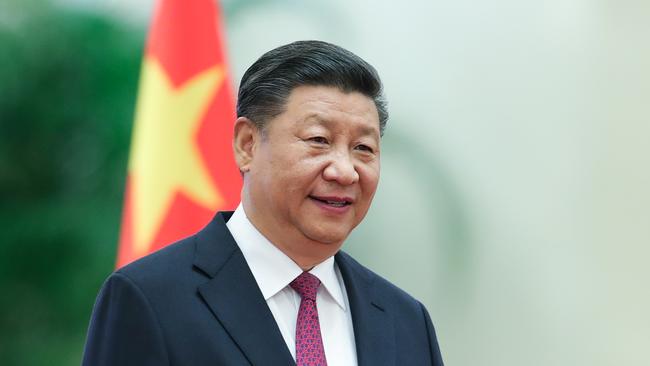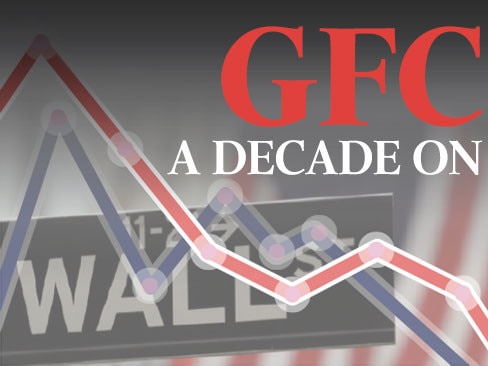GFC 10 years on: How the GFC marked helped China make a great leap forward
The financial crisis of 2008 gripped the West and caused global havoc; it also opened the way for China’s great leap forward.

The financial crisis which gripped the West from September 2008 caused severe economic hardship in the US and Europe, but it opened the way for a great leap forward for China.
By 2008 China was already powering ahead, overtaking Germany as the world’s third largest economy.
China was not immune from the fallout of the global financial crisis, but its limited integration with world financial markets, its small amount of private sector borrowing at the time, and its government-led economy — with the capacity for ongoing public stimulus — saw it emerge far stronger in the wake of the crisis.
It overtook Japan as the world’s second largest economy in 2010, and its current trade war with the US represents a battle between the two economic giants of the world.
While Australia likes to pat itself on the back for its almost 30 years of uninterrupted economic growth, the main reason was the rise of the Chinese economy and its demand for Australian iron ore, coal and other resources and a new demand for food and other consumer products.
In his book, The Party, the Secret World of China’s Communist Rulers, published in 2010, Australian journalist and China expert Richard McGregor describes the big shift in thinking among Chinese officials in the wake of the global financial crisis. Before the GFC, he writes, Chinese officials and regulators looked to events such as the annual Boao forum on Hainan Island, which started in 2001, to learn from Western bankers, economists and regulators about how best to run their own financial system.
But the crisis saw Chinese officials becoming more confident in their own view of the world and less worried about learning lessons from the West.
“The implosion of the Western financial system, along with the evaporation of confidence in the US, Europe and Japan, overnight pushed China’s global financial standing several notches higher,” McGregor writes.
During the GFC Chinese officials were already becoming confident in their economic success. Afterwards, he says, they were starting to ask themselves: “What on earth have we to learn from the West?”
Instead of being one of the poorer relations, the post-GFC world order saw China, with its trillions of dollars in cash reserves, buying US Treasuries and beginning its global aid and lending spree helping to insulate other economies from the worst of the downturn.
Just as World War 11 changed the mindset of Britain’s Asian colonies towards Britain and the European powers, prompting them to go it alone as independent nations, so has the GFC highlighted the flaws in the Western economic system for the emerging China, paving the way for its own economy to continue growing and its leaders to become confident about their role in the world.
China was able to respond to the crisis with a massive infrastructure spending spree from 2009 which powered its economy, with a host of new airports, roads, gleaming new office buildings and, more recently, a massive network of high-speed trains that is transforming travel in the country.
“The GFC was for China in many respects a great triumph,” McGregor told The Australian this week.
“Not only did it display what they regarded as fundamental flaws in the Western democratic model — one they had been constantly lectured to emulate — China’s own system was able to respond rapidly to ensure the country’s economy recovered didn’t fall into the same hole.
“China has a lot of problems at the moment, from a wobbly currency to social unrest and anger at Xi Jinping’s monopolisation of power, but that confidence spawned in the GFC has hardened since then, especially with the election of Donald Trump.”
McGregor argues that the 2016 election of Trump as US President has only confirmed China’s view of the merits of its own political system. “The Communist Party reckons that its system is a meritocracy, so the best people ascend through the system.
“Trump’s election was the best evidence so far, from their viewpoint, that this does not happen in democracies.”
But McGregor warns that China’s massive borrowing spree since 2008 could contain the seeds of some home-grown problems for the world’s second largest economy.
“The downside of the GFC for China was that the economy again became over-reliant on investment, in property and infrastructure.
“It ran up huge debts at a local level, in smaller cities and townships, and in their affiliated banks, leaving Beijing with a huge mess.”
He argues that China can only clear it up if Xi is persuaded to accept lower rates of economic growth in China, but adds “there is no sign of that at the moment”.
“If you wanted to sum up the downside, the GFC has left China overconfident, and in huge debt which it has to clean up.”
Writing in the South China Morning Post, columnist Tom Holland argues it was the rise of China as a global manufacturing power — given a boost by its joining the World Trade Organisation in 2001 — which was inadvertently responsible for the crisis.
He argues that China’s emergence as a supplier of cheap manufactured goods for the West underwrote a long period of not only low inflation but falling prices for goods.
He argues that the new era of low inflation in the West lulled governments and their central bankers into believing that it had come about by their own policies and they began to cut interest rates.
“Politicians and central bankers in the West misread the signals, attributing this ‘great moderation” (in their inflation rates), not to the influence of China but to the effectiveness of their own inflation-fighting policies,” he wrote.
“In response, they cut interest rates to the lowest level in 40 years”, paving the way for a massive private sector borrowing spree.
Lulled into a false sense of security, they also pushed ahead with the ongoing deregulation of their financial sectors, which saw banks leverage up their balances sheets, going on lending sprees that fuelled the heady times and the excesses of the lead up to September 2008.
Doug Ferguson, KPMG’s Sydney-based partner in charge of Asia, has seen the changing role of China over the past decade since 2008 through his own career lens.
“Ten years ago I was working in Hong Kong as a newly made partner when KPMG was appointed as the provisional liquidator for Lehman Brothers Asia,” he told The Australian this week.
“For the next three years I worked full time on managing, restructuring and selling Lehman’s principal real estate investment positions in China, Hong Kong, Thailand, Malaysia, Vietnam.
“It was a period of immense pressure and concern, where asset valuations were plunging, multi-jurisdictional litigation was burning like wildfire and a wide cross-section of Asian society (not just investors or employees) were wondering if a global depression was to follow.
“Fortunately China took the regional lead in the first quarter of 2009 with an unheralded fiscal and monetary stimulus package to pump prime their economy.
“Suddenly the confidence came back into the real estate market, enabling our team to sell the Lehman positions in China for close to full value.
“Most of the new investors were Chinese insurance companies, real estate developers or banks and they understood the long-term value to invest and grow while Western banks and hedge funds thought it was an opportunity for deep discount bargains.
“They were wrong.”
By 2012, with most of the Lehman assets sold, Ferguson’s role gave him a box seat in watching a new phenomenon — the emergence of China as one of the world’s new global investors with Australia being a major recipient.
“By 2012, it was time to move home to Australia,” he said.
“From 2008, Australia was for a time the largest single country recipient for Chinese ODI,” he said.
“It was mostly from Chinese state-owned enterprises into our mining and gas industry projects in Western Australia and Queensland.
“This investment, the exports and the jobs it created in many ways underwrote Australia’s survival from the GFC, something we should always remember and be appreciative of.”
Research by KPMG and the University of Sydney shows that between 2008 and 2017, Chinese companies invested roughly $US100 billion in capital to Australia. This peaked on an annual basis at $US16.2bn in 2008, with investments into big mining projects, and Ferguson points out it is still continuing with $US10.3bn of new Chinese investment into Australia last year.
“These days, it’s the private Chinese companies and funds that are investing into Australian real estates, healthcare, food, education and tourism sectors which sell products both domestically and export Australian branded goods to China,” he says.
“This investment and the flow on effects creates new opportunities for Australian companies, employees and end consumers.”
In Chinese, the word for crisis is made up of two words “danger” and “opportunity”.
The past decade has shown that the dangerous financial practices of the West became China’s great opportunity. But as it grapples with its new role as a world economic strongman — and has to wean itself off its post 2008 debt binge — the next 10 years may well prove to be more challenging.





To join the conversation, please log in. Don't have an account? Register
Join the conversation, you are commenting as Logout